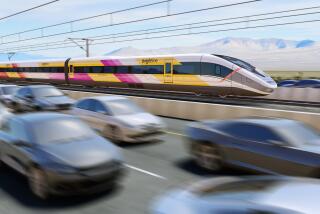Maglev Trains Could Get U.S. Transit Back on Track
- Share via
During rush hour in Shanghai, China, recently, I traveled 19 miles in 7 1/2 minutes. I wasn’t flying, exactly. I was aboard a high-speed magnetic-levitation transportation system. Ever since, I can’t help but ponder more efficient ways of moving people into, between, within and around American cities; especially when I am stuck in traffic jams.
Let’s face it, American transportation problems result from our love of private automobile ownership and the government policies that enable our oil addiction. Driving cars in cities is like using a pair of pliers to bang a nail into a wall -- the wrong tool for the job. It is analogous to entering the lobby of a high-rise and waiting for an elevator that only one person at a time can ride because everyone wants their private space.
Subways and light-rail systems, typical U.S. alternatives, are basically 19th century technologies. As wheels meet tracks over years of use, these systems wear out. They are slow, bouncy, expensive to maintain and prone to frequent breakdowns. Mostly manually operated, they require high labor costs.
Maglevs, on the other hand, float -- propelled and supported by electromagnetic waves. They’re not free of maintenance, but logic dictates that by eliminating sources of friction from traditional propulsion and braking, much higher system reliability and fewer repairs will result. They’re not cheap to build, but in low-speed versions they can cost less per mile to install than some light-rail systems now being constructed in the United States.
The high-speed (267-mph) German-built maglev in Shanghai is one good model. It is smooth and much faster than highway or traditional rail travel, fast enough in fact to compete with air trips of 600 miles or less (which means it could eliminate the need for about 50% of all domestic U.S. air travel). A lower-speed (60-mph) maglev is being finished east of Nagoya, Japan, and will shuttle passengers to nine stations along a 5.6-mile route. This elevated maglev system is ideal for tight urban landscapes with restricted rights of way and frequent stops. It can negotiate tighter turns than higher-speed systems and silently “fly over” communities and highways.
Both these systems are computer controlled and operated, which makes them more reliable than manual systems. Both are projected to beat the life-cycle costs of all other traditional transportation systems.
So far, there are no maglevs in the U.S., but there are three in various stages of planning, discussion and funding just where they’re needed most: traffic-crammed Southern California. The Southern California Assn. of Governments has a plan for one that would link local airports. The Orange Line Development Authority plan would link Orange County to Los Angeles. And a for-profit group is furthest along, with a plan for a maglev operating between Anaheim and Las Vegas.
Obviously, the big question is how to pay for them. Each project is hoping to go forward through public and private partnerships of various kinds, and each will require some innovative thinking. For example, given that maglevs might ease the need for air travel, Congress could divert tens of billions of dollars from planned airport expansion projects to build maglev intercity connectors.
My ride in Shanghai is proof: The technology exists to meet our burgeoning transportation needs. What we need now is the public will and the political leadership to make the move.
Kevin C. Coates, a Washington transportation and energy consultant, is at work on a book about maglev technology.
More to Read
Sign up for The Wild
We’ll help you find the best places to hike, bike and run, as well as the perfect silent spots for meditation and yoga.
You may occasionally receive promotional content from the Los Angeles Times.






